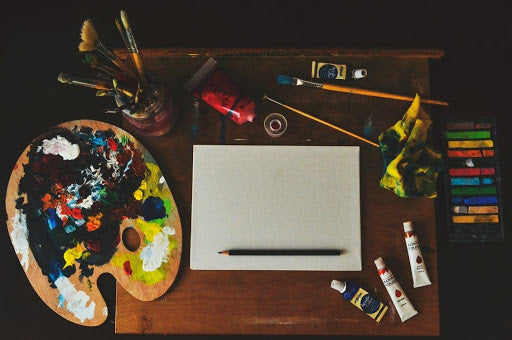Abstract Art Famous Techniques 📰

While the earliest forms of art were focused on replicating reality, the Modernist movement led to the diversification of art into many different forms, with some prominent ones being abstract art and impressionism. Once the need to display concrete reality was gone, artists were no longer bound by the limits of what we see and perceive and instead had the opportunity to start painting beyond the lines.
Now, the world of abstract art has given artists the option to keep some semblance of reality in their work to create their own unique techniques. Since abstract art is ever-evolving and highly dependent on individual artist style, there is no set list of abstract art techniques, but there are some common ones that can be seen in the works of some of the most famous abstract artists such as Jackson Pollock and Mark Rothko.
Read on as we look at some of the most famous abstract art techniques, how to appreciate an abstract painting, and how to create your own masterpieces.
Basic Abstract Art Techniques
Abstract artwork follows some basic techniques which you might commonly observe in a lot of paintings by artists who are famous or anonymous:
Action Painting
You’ve probably seen action painting in your life many times before – paintings that include splatters, drips and similar fluid marks all come under this. The concept behind it is for abstract artists to free
Decollage
Decollage is not a technique that refers to paint, but it is more about layering the canvas and then peeling, tearing, or cutting the layers in a certain way to reveal the work of art. Think of it as the planned, sophisticated version of the jumble of posters and ads that build up on signboards and telephone poles.
Collage
This is quite obviously the opposite of decollage, and it involves layering any type of material, even paint. Perhaps the most famous example of creating collage paintings was Pablo Picasso, who used cubism in his artwork. Artists who use layering and collage making claim that they are creating the true version of reality by adding elements the way they perceive them.
Stain Painting
Staining is a technique that dates back to the mid-twentieth century. The technique involves thinning out the paint and applying it onto unprimed canvas, allowing the paint to create its own course of direction. This style of painting is similar to action painting, but instead of controlling the way the paint splashes and moves across the canvas, the idea is to let the color flow freely. Famous artists such as Kenneth Noland have been known to make use of this technique in their paintings.
Color Field Painting
It is believed that staining was the foundation of what is known today as color field painting became popular among mid-twentieth century artists and was first popularized in Europe, after which it spread to the States, Canada, Australia, and so on. The technique entails using a single solid color or a combination of solid colors across the entire canvas to create a complete, unbroken image. Instead of focusing on adding multiple shades or using unique brush strokes, this technique is more about creating a cohesive, consistent painting. Instead of using color to create something on the canvas, the color itself becomes the main attraction in the artwork. Color field paintings usually have subtle, understated formats with geometric designs, repeated patterns, and so on.
Fabrication Painting
Fabrication painting was another technique popularized by minimalist artists sometime after World War II. This concept eliminated the concept of an artwork being the sole effort of the artist alone. Artists would be the designing minds, but the production, regardless of what the canvas was, was done by manufacturers.
If you’ve ever used stamps as a child or created hand turkeys, then you’ve already used print painting in your life. The concept involves transferring artwork onto the canvas from another prepared surface such as screen printing, using pieces of wood, etching, and so on. Commercial artists have used the print technique to make their artwork widely available – it comes with the bonus that even if the foundation of each painting is the same, the transfer of color onto the canvas is always slightly different and unique.
Other Techniques
Since abstract art is not limited to paint and canvas, there are many other techniques that apply to different materials. For instance,
- The relief technique creates a protruding image off a solid surface and may include a combination of materials to create this multi-dimensional image.
- The assemblage technique uses different materials to create three-dimensional artwork – it is not the same as sculpting, where a single surface is both the canvas and the material which is carved to create the final piece.
A Glance into the Past
Abstract art, as we know it today, has evolved from the work of some of the great artists throughout history, especially after World War II. Let’s take a walk back past the last hundred years or so to see what doors they opened to build credibility for abstract artists today. The techniques that many people without any artistic interests perceive as the work of a child, worthy of being put up on the refrigerator are actually techniques that date back decades ago and are the representation of the thought processes of some of the most brilliant minds to ever exist.
Artwork from 1910-1929
Kandinsky’s Untitled
Considered by some historians to be the first-ever abstract painting, this piece is a combination of bold colors on a muted background, swirling lines with non-symmetry, smears, and hidden swooshes of color. This painting was the first realization for artists everywhere that there is no need for them to be bound by physical, real subjects, and that an image doesn’t have to be a carbon copy of reality. In fact, this painting was so far from being anything that anyone had seen before, that it is the perfect definition of abstract art as we know it. He was the first to make use of many of the techniques discussed in the last section to create his own reflection of the way he perceived the world.
Joan Miro’s La Mancha Roja
The name of this art piece translates to the red spot and is a representation of Joan’s general art form. In fact, the artist himself didn’t even consider his work to be abstract – it was simply his way of letting out his thoughts and emotions after reaching home in a state of fatigue and hunger. The closer you look at his work, the more it looks like the embodiment of nightmares and the darkness that hides in the shadows. It is a collection of our imagination and the thoughts that our mind suppresses instinctively.
Piet Mondrian’s Tableau I
This piece is the furthest style from Kandinsky’s work, and yet both of them come under the branch of abstract art, showing just how open-ended and diverse this field is. Unlike Kandinsky’s work, which was full of non-symmetry, swirling lines, and more, the Tableau I shows a more controlled, symmetrical form of abstract art. The use of solid black lines is used to show definitive geometric patterns and the precise use of lines and colors.
Artwork from 1930 – 1949
The end of World War II brought with it some level of industrial development, but also famine and other side effects of war. During this time, art forms saw a revolution as people sought to escape from the mundane truths of reality to something that was more freeing.
Ben Nicholson’s White Relief
Ben Nicholson used the concept of layering paint and combining straight lines and geometric patterns to create relief paintings. This was the first step into impressionism in art and how even a single color, even white, can be used to convey an artist’s thoughts and emotions.
Jackson Pollock’s Full Fathom Five
If you’ve even remotely heard of abstract art, the name Jackson Pollock must already be familiar to you. His work makes use of many of the techniques we’ve talked about, and despite his being an artist at the time when minimalism was on the rise, his work is anything but. Using brushwork, action painting, and more, Pollock created this piece as a depiction of post-war anxiety. He used scraps of materials in his studio, ranging from cigarette butts to coins and more to create depth in the Full Fathom Five, which became the starting peak for his fame as an artist till today.
Artwork from 1950 - 1959
By the 1950s, abstract art had already settled into the art world, and instead of being a novel concept, it was now a norm for new abstract expressionists to create their own unique styles. This was also the period when color field painting started to grow into a proper art form. Unlike the previous decade where war-ravaged spaces saw art containing anxiety and depression, the newer work was full of strong, meditative, and calm energy.
Helen Frankenthaler’s Mountains and Sea
Helen is considered to be a leading name in the world of abstract art, and while her work started to gain popularity in the 1950s, it is believed that she had already started creating abstract paintings well before the time of Kandinsky who is often considered to be the first real abstract artist. She is considered to be the brains behind the stain painting technique, which is what she used in the Mountains and Sea painting. The idea was to create soft, organic textures on the canvas. This piece is at the heart of the color field movement and leaves art lovers awestruck, even today.
Mark Rothko’s No. 2 Green, Red and Blue
Rothko is another golden name in the abstract art world and another champion of the color field technique. While to the untrained eye, Rothko’s work at first glance may be solid colors with no symmetry or depth, a closer look reveals the artist’s true emotions and has left many viewers filled with the raw feelings displayed in the artwork such as the depressive colors used in his later works.
Abstract Art Today
The work of abstract artists from decades ago has paved the way for artwork and paintings that allow artists to break free of the chains of following fixed techniques and patterns and finding what works for them. Contemporary artists today owe everything they have to great minds like Rothko and Frankenthaler for opening up the world to new art forms like color field painting.
Till today, abstract artists use their motivators, whether it’s fear, anxiety, joy, or a calling from beyond to create artwork that goes beyond the reality that our eyes can see. From renowned artists to lesser-known ones, everyone has their own unique style of conveying their thoughts and emotions.
What Abstract Art Means for the Common Man
One of the great transformations in the world of art is that it is no longer something to be appreciated by elitists, in museums or galleries. Contemporary abstract art can be hung and displayed in domestic spaces to allow you to escape from the concrete reality of the world and take a glimpse into what the human mind really looks like. The longer you look at a piece of abstract art, the more you’ll be able to see the feelings and plan behind it.












